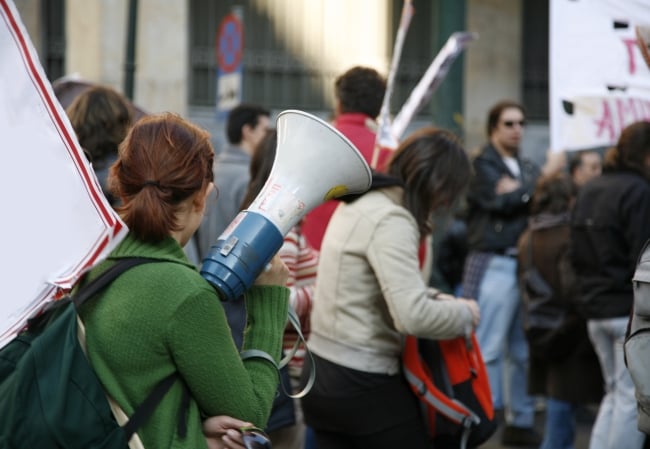You have /5 articles left.
Sign up for a free account or log in.

The University of South Carolina created its first-year seminar program to instill belonging in incoming students following student protests in the 1960s and ’70s. John Gardner, of the Gardner Institute, reflects on the events and how they apply to today’s students.
vasiliki/E+/Getty Images
Since the start of the Israel-Hamas war in October 2023, colleges and universities have seen heightened tensions on campus as student protesters demand change from their administrators.
Antiwar protests on college campuses are not a new phenomenon; many institutions saw similar unrest during the 1960s and 1970s during the Vietnam War. The University of South Carolina was one such institution, which saw a general unrest among its student body amid racial tensions, the antiwar movement and other institutional grievances, which came to a head in May 1970.
USC officials took an unconventional approach to mitigate student frustrations, which included implementing a comprehensive University 101 course, meant to infuse feelings of belonging among participants. The initiative was largely successful, with the university experiencing no student riots for another 50 years.
Most Popular
In this episode, host Ashley Mowreader speaks with John Gardner, one of the professors who helped create the first-year seminar at USC and founder of the John N. Gardner Institute for Excellence in Undergraduate Education, to reflect on past protests and share the importance of belonging in the first-year experience.
An edited version of the podcast appears below.
Listen to past episodes of Voices of Student Success here.
Inside Higher Ed: I first learned about USC’s history with the first-year seminar at the National Resource Center for the First-Year Experience and Students in Transition event earlier this spring. And I actually, I was looking at my notes, and you said something that has aged, maybe not quite as well, but you said, “The conference series is an outgrowth of something you don’t want to happen, and that’s a student riot, although these days I wish they would riot, because they’re putting up with a lot of crap that they shouldn’t have to put up with.”
Gardner: I agree. I agree with you, and I’m amazed they haven’t before, really amazed that it took this long to do it.
Inside Higher Ed: Really? So the sentiment still stands?
Gardner: Absolutely, sentiment still stands. Your comment about aging, you meant the course’s age, not me, of course—I don’t [age]—but it is quite astonishing.
The 52 years as we’ve had the course, there were several times when I wondered if the students would protest, but they didn’t. It’s only a theory I have about this, and that is, did the students have a set of experiences that generated such goodwill towards the institution? Did they trust us to make things right? They know that not everything is always going to be perfect, but if you set out, as we did, to, quote, “Teach students to love the university and to love being there and experiencing it,” you create these self-fulfilling prophecies.
The idea was not to say, “Love us, right or wrong.” That didn’t mean you have to tolerate anything and everything we lay on you. It meant, you need to understand our intentions and what we’re trying to do with you, and try and work with us to let us do this. But maybe I’m getting ahead of where you want to take this.
Inside Higher Ed: Let’s back all the way up to 1970. Can you tell us about the origin of the first-year seminar at the University of South Carolina?
Gardner: I certainly can. It’s very connected to something that’s very timely now, which is the reappearance of significant and widespread student disturbances on American colleges and university campuses.
So what you’ve asked me is to describe the origins of how the University of South Carolina, why did it start a comprehensive, credit-bearing course offering to new students on an elective basis? Now, about 85 percent of the students take this course; it’s now 52 years old. It’s called University 101, the Student in the University.
This course was started because of a student riot. And it was not a riot; it was a serious disturbance. This took place in the second week of May in 1970 at the University of South Carolina’s campus in Columbia, S.C. It was the response to the student demonstrations that provoked this, and the governor of South Carolina called out the National Guard to disperse students who were gathering on the heart of the campus, geographically at a region that’s designated as the Horseshoe, but this wall was originally built by slave labor to keep students in and to prevent them from going off the campus in order to drink excessively and get in duels and so on. This was built in the 1820s, but what’s seen is that the efforts by colleges and universities to wall out the external culture don’t work very well. That particular university … it didn’t prevent Sherman from burning most of Columbia, although he spared the university, and it certainly didn’t keep the Vietnam War out.
But the fact that the students were challenged by the South Carolina National Guard when they had gathered peacefully to protest the American, what our government called an incursion—not an invasion—of the sovereign nation of Cambodia in that second week of May 1970. The students were very unhappy about that, but they were protesting that, along with a number of local issues; there were things they were unhappy about that the administration had done with them. It all converged.
Now, I hate to say this, but what the authorities did in South Carolina and Columbia May of 1970 was preferable to what they had done some 27 months previously, when there was a student protest in a little town called Orangeburg, S.C., in February of 1968, where the local authorities could not handle a group of about 200 students from two historically Black colleges in Orangeburg that had gathered to protest the continuing segregation of a bowling alley four years after the Civil Rights Act.
They called the local authorities, called the Highway Patrol, who arrived and opened fire. They shot at the students, and they shot 33 of them in the back. Three of them died.
Two years later, when students gathered at the University of South Carolina, which was an overwhelmingly white campus—not like an HBCU, where the students had been shot—but there was a predominantly, overwhelmingly white protest demonstration. Those students were tear-gassed, but they weren’t shot, so it’s a slight improvement.
Now, this happened while the Board of Trustees was meeting at the same time about 100 yards away in the administration building. The students went up there and attempted to set the building on fire. The president was upstairs in his office. They barricaded him in his office. He allowed them to sit in and occupy the building—which was not well received by some members of the local community who felt the students should have been bodily ejected.
Same now: When you’re running a university, how do you respond to student demonstrations?
This president decided that it would have been counterproductive to, in turn, use force against them, even though the students were misbehaving. I mean, they attempted to set the building on fire, right?
He held a press conference the next day, this is a man by the name of Thomas F. Jones, who was an engineer by training. He was a graduate of MIT, growing up in Mississippi, but coming to South Carolina in 1962 as its president had made him a human engineer. He had already had a number of things underway to try to change the culture of the university, but it wasn’t sufficient to prevent this student demonstration.
So he held a press conference, and he told the press and public that, quote, “The students have given me an extended opportunity for reflection on the meaning of student behavior.” Now, that’s very important symbolic language, because he’s saying that to figure out what to do, you have to understand students. You have to have studied them. You have to observe them. You have to interact with them [with] true civility. And that’s what he did.
He promised that he would get to the cause. As a result of his observations, he observed they were angry. So as presidents frequently do when faced with a crisis, he promised the students that he would form a major task force, which he did, to study the causes of student unhappiness and to propose a set of recommendations. That was a lengthy process. It took two years. There was a major retreat held with students and faculty administration.
Another thing he did was he came to the faculty, as there was a task force, with a recommendation that the university create a course to teach students how to do university, how to be university students. What could a university do that would improve and benefit them and their lives? In the president’s words, the goal was to teach students to love the university.
His argument was, if we taught them to love the university, they wouldn’t trash it. They would respect it. But we had to be genuine about this. We had to carry through.
So how do you teach students to love a university? That became the question, the guiding question, then, to have a positive, successful adjustment. We didn’t start this in order to retain students … The course started September of 1972, and two years later, examining what was happening to these students, there were no more riots—so far, that was working. What could be learned about this experiment? It was an experiment, and the experiment decided, to use the modern term, [to] assess the outcomes for this course, because we had a new president who came in in 1974.
We administered a study in the English 101 course, and we asked all the students, as part of the demographic questions, are you taking University 101? Those that said yes, we could read their answers differently from those that said no.
What we found was the students who took this course, they knew more about how the university was organized and what it offered to … help students. And not only that, they were more likely to have gone to seek assistance, which, now 50 years later, we know that students who get help are more likely to persist and succeed.
We know that women are more likely to do that than men. One of our challenges especially is to get the men engaging in these more beneficial behaviors.
We found out that they were more likely to get help. Another thing we found was they were more likely to join clubs, organizations [and] activities than people who hadn’t taken this course. We know that students who join university or college-sanctioned activities are more likely to bond and connect and persist.
Another thing we asked them about, how they would rate their experience joining the university? Was it positive, negative? What we found was the students who took this course had a more positive perception of what the university had done to orient them to the university.
We also found that students who took this course were more likely to interact with faculty and staff outside of class, and this of course was something that was encouraged in this, because we wanted those of us who worked at the place to have relationships with students.
Now, the other piece of this that was so important, and that has been continued for 52 years, to the president’s hidden agenda about preventing riots, was that you don’t just create a course, put students in it. You gotta have faculty and staff. In this case, he invited student affairs staff to also teach this course, but those faculty and staff had to be prepared. They had to be shown how they could teach students to love a university.
So the hidden agenda here was to use the riot and the need to have a positive experience for students as a raison d’être—a rationale, an excuse—to provide large-scale faculty development, to provide faculty with information about students that they wouldn’t have had learned in their own graduate programs, and especially about the kinds of pedagogies you can use in classroom settings that build closer faculty- student-staff relationships.
Really, the course had two purposes: It was a course, fundamentally, for students, but it was a course for those who teach the course.
I was invited to participate in the first training program to prepare me to teach this course. I’d never had anything like this, and it transformed the way I approached my students. Now I was quite young—what was I, 28? Thirty? Somewhere around there. I’d never had any preparation like this to be a university teacher. It had a huge impact on me, but that’s what it was designed to do. It prepared me to teach this course, to work with first-year students.
So let me put the big picture here. This disturbance that took place was the result of in our history, in 1970, as a country. There was a convergence of four factors. And I think right now, what’s going on, we have to understand the factors that are converging and meeting in these confrontations between demonstrators and university administrators. Ideally, we need to find ways to not make them confrontational.
There were four major things going on in our country: No. 1 was the civil rights movement, and the second thing was the student rights movement. The third thing was the antiwar movement, and the fourth thing was the women’s movement. All of those things were evident in that student demonstration and were things we needed to respond to as a university.
The question now is, what are the major issues that are bothering students in their university experiences, and just by being American, late adolescents, early adults, middle-aged adults, all adults in the United States of America? All of that is at play here. It’s been exacerbated by how we’ve been treating students since the pandemic, when we increasingly reduce the amount of human contact we provide for students, when so much of what we offer students now is, “Get it on the web, do it online.” We do not have the relationships with many of these students that historically, for 350 years, we’ve had with our students. I believe that is contributing to our inability, seemingly, to communicate with these students.
Inside Higher Ed: One thing I was wondering, it seemed countercultural at the time, to address student needs head-on, right—to listen to what the students wanted, to reflect, to get the whole campus community on board with that and to administer belonging, if you will, as the antidote to student conflict and disruption. Would you say that’s still something that rings true with today’s students? That belonging is something that can mitigate conflict?
Gardner: I don’t want to argue that belonging is a panacea, but I do want to argue that when people feel like they belong, they behave differently. They have an identity, the group that they feel like they belong in, they respect those people, they have affection for those people, they listen to those people. Their interactions are different. Their attitudes are different.
We’ve done a tremendous amount of research on this course and its students over 52 years. The biggest gain, the biggest difference we see between the students who take this course and those who don’t is their sense of belonging as we measure that at its level at the time they graduate.
We’ve known, for centuries, really, there’s certain things you do to inculcate new members of a group, and if you do these things properly, they’re going to feel more like they belong. They’re in healthy, functional relationships, where they’re being nurtured, where they’re being noticed, where they’re being attended. The Gallup study of a few years ago that they did with Purdue University found that the students who had the most positive attitudes towards the university were students who had meaningful relationships with other students and with faculty, who had done meaningful work, and that they had been noticed and affirmed. There are huge benefits from this.
So I think if we would do more to develop the kind of relationships between people who lead universities and the students, we would not be in the situation where we are now this. These students obviously felt alienated. They weren’t being listened to. They felt they were being discriminated against, marginalized. That doesn’t happen overnight. They obviously have had a series of experiences that led them to have these feelings towards the particular university where they were demonstrating.
Inside Higher Ed: The first-year seminar as a forum for this kind of work has changed dramatically. I hear a lot from student affairs professionals that it’s almost like a catch-all setting for any sort—“we need to teach them about how to use the LMS. We need to teach students how to use the library,” or things like that. Do you think the first-year seminar today can still function as a place to foster belonging?
Gardner: Well, it can, if the course is designed and executed with that as a goal, and if the institution has helped its instructors of that course show how to achieve that goal.
What you’re saying that student affairs folks are saying has happened a lot of these courses, is absolutely correct. My wife, Betsy Barefoot, who’s done a lot of writing on the topic of the first-year seminar, she refers to the phenomena you’re talking about is the “homeroom,” when University 101, College 101—whatever these courses are called at any given university—the homeroom where everything the institution doesn’t get to students by way of information and advice in any other context. If they try and dump it all in that one experience, it’s going to be too much. You can’t do everything, so you have to decide what is most important.
And a lot of this, what needs to be done can be done in part by upper-class, older, wiser students, if they are brought into the role of helping to inculcate and orient new students. This course that I’m describing now 52 years later, since about 1990, this course is co-taught by undergraduate students, by what we call peer leaders, and they have an enormous influence on students.
Entering students want to behave like the older students that they see, but generally, most universities don’t try and take some control over this—control in the sense of deliberately putting forward the best possible role models for students who are available to those students to help them achieve the sense of belonging, but also get the advice they need, in combination with the faculty or staff member that’s teaching this [course].
I think the criticism that you’re reporting, I think it’s a valid one, but I don’t think it has to be that way. There are many ways to get students information. You can’t do it all. You’ve got to decide what are going to be your priorities in this course, and if they’re not going to get this information in this course, where are they going to get it? It has to be somewhere.
Inside Higher Ed: You mentioned faculty and staff development was part of the original purpose of the first-year seminar as well, to teach people how to teach. Where do you see that in the modern first-year seminar? And how is that still ringing true in preparing educators to be instructors?
Gardner: Because the University of South Carolina, exactly a decade after they created the course in 1972, the university organized what is now an annual event called the National Conference on the First-Year Experience. I created that in 1982. And I can tell you, we’ve done it now for 42 years; many institutions have sent people to that meeting, thousands, and they’ve gone back and they have adapted their own version of something like University 101.
It can’t be the USC model in an entirety. It’s got to be reflective and expressive of the unique characteristics of the given institution. But what I can tell you is there are two parts here for replication. One is, what are we doing for the students? But the other is, what are we doing for the faculty and staff who teach these students?
The majority of institutions now that offer these first-year seminar courses, they’re providing some kind of preparation for the instructors, and that’s what makes me most hopeful about this, because it’s an effort by colleges and universities to do what historically they didn’t do. Historically they assumed, “Well, these people on the faculty, they’re well trained, they’re well educated, they’re experts in their field. We don’t have to help them learn about principles of effective college teaching.” We do need to do that today, because the differences between the students and the faculty are enormous in many respects, and the way these two groups learn is very, very different.
You know, faculty are very smart people. They can learn what they didn’t learn previously about human behavior and interaction and group dynamics. They can be taught all that we’re smart people. We can learn that we can modify some of our behaviors. I did it. Anybody can do it.
Inside Higher Ed: You’re a testament to it being true.
Gardner: And more colleges, universities are now trying to improve the pedagogy, and the focus is even more broadly, not just in first-year seminars, but in what we call gateway courses. These introductory courses that are failing high numbers of students. The nonprofit that I’m affiliated with, the Gardner Institute, we do a lot of work with colleges and universities around helping their faculty adopt new pedagogies to teach these gateway courses, to reduce the failure rates, to, in turn, reduce the attrition rates. And a lot of that is what we learned through University 101.
Inside Higher Ed: So preparing for the fall, there’s, I would say, a healthy dose of skepticism about how student conflict will look this fall given the events of the spring. And also, we have a presidential election this fall. If you could give advice or insight based on your experience with developing the first-year seminar and promoting student belonging through University 101 courses, what would you share with college leaders?
Gardner: I would share the following: This is not rocket science or unique to me. Campus leaders, they need to not wait until the protests of the students gather; they’ve got to make an effort like they never made before to get out and interact with students. And to recognize it’s not just the senior management of universities, it’s university faculty and staff generally. We’ve got to be much more accessible to these students, much more willing to talk with them, meet with them, attend things with them than historically we have become in recent decades. Because these students are alienated from us. They’ve got to do pretty dramatic things to get our attention. They shouldn’t have to do that. They should be noticed.
There have to be more venues and opportunities for deliberate interaction between those of us who are professional higher educators and our students. There have to be more forums to provide safety valves for students to blow off steam.
How colleges and universities are working with their student leaders, the leaders they put in positions of authority in residence halls, for example, and working with the students in student government and the students who manage the student newspapers—there are all kinds of ways we can reach out to students, and we better be doing it, or we’re going to pay a very high price.
They’ve [students] also got to trust us. A lot of this is, they don’t trust us to do what we say we’re going to do. One of the things talk about in the University 101 training is we are trying to say, “Look, if students come to believe you, they’re more likely to do what you’re advising them to do.” The question is, how do you get anybody to believe you? That is, how do you build trust?
Certain behaviors, both individually and organizationally, generate trust. What you saw, what we all saw, on many of these campuses was adequate expression of the view that “we don’t believe you folks,” directed to the administration. Administrations are going to have to take more responsibility for doing what they say they’re going to do and acting in good faith.
I believe that universities can learn how to do better with this; we did so in the ’60s. I think that students’ expression of concerns, complaints, disaffection is healthy, and I want to see colleges and universities remain bastions of academic freedom, where students learn that—unlike in secondary school—they have a right to express themselves. I think that we can teach students, particularly during the entering college and university period, how to express themselves using the channels we have and the forums we have, very simply, to use the freedom we’re giving them.
We’re giving them all kinds of freedom they didn’t have in secondary school. And if you’ve been given something that you’ve never used before, [and] you don’t know how to use it well, you may not use it well. It’s about learning to use responsibly the freedom that we give students in colleges and universities, which includes the freedom to speak up. We need to listen to them. It can be difficult, yeah, but [it] can also be a hell of a lot of fun. That we can learn.








